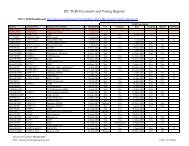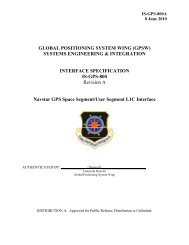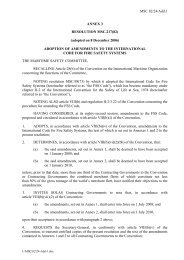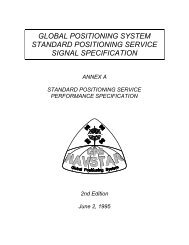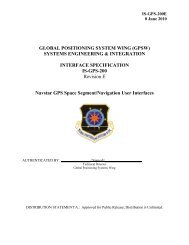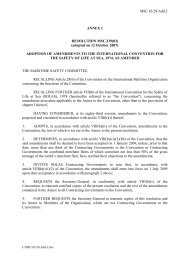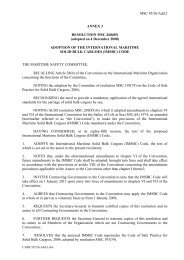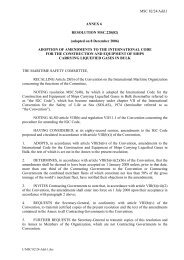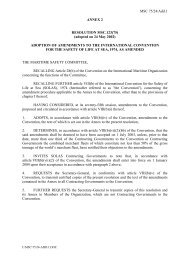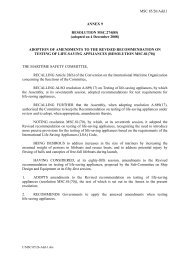The LORAN-C System - US Coast Guard Navigation Center
The LORAN-C System - US Coast Guard Navigation Center
The LORAN-C System - US Coast Guard Navigation Center
Create successful ePaper yourself
Turn your PDF publications into a flip-book with our unique Google optimized e-Paper software.
labeled in terms of time difference (TD). All that is necessary tocalculate the theoretical time difference for any point in Figure II_4is the speed of signal propagation and the CD of the X-ray secondary.To a first approximation, 7 loran signals travel at the speed of light ittakes approximately 6.18 usec for the signal to travel one nauticalmile.Now consider point A again in Figure II_4. <strong>The</strong> distance from the masterto point A is 512.5 NM, so the signal from the master would takeapproximately 6.18 (512.5) = 3,167 usec to reach a vessel at point A.<strong>The</strong> arrival of this signal starts the TD measurement in the vesselsloran receiver. When will the signal from the secondary arrive? Recallthat the secondary transmits after an emission delay, equal to thebaseline travel time plus the secondary coding delay. <strong>The</strong> master and X-ray secondary are 400 miles apart in this illustration, so the baselinetravel time (or baseline length in usec) is approximately 6.18 (400) =2,472 usec. Assuming a CD for this secondary of 11,000 usec, 8 the X-ray secondary would transmit 2,472 + 11,000 = 13,472 usec after themaster. This signal must travel approximately 212.5 NM to reach thevessel at point A, a travel time of 6.18 (212.5) = 1,313 usec. Thus, inthis example, the signal from X-ray would arrive 13,472 + 1,313 =14,785 usec after the master transmission. <strong>The</strong> observed TD at thevessel is this time, 14,785 usec, minus the time that the master signalarrives at the vessel, previously calculated as 3,167 usec. <strong>The</strong>theoretical TD (based upon these assumptions) at the vessel is 14,785 -3,167 = 11,618 usec. This calculation is summarized in Table II_2 andthe time lines are shown diagrammatically in Figure II_5.Loran LOPs can be displayed as distance differences or equivalently asTDs. Because TDs are measured on the receiver, these are shown on loranoverprinted charts.Returning now to Figure II_4, the LOP on which point A is located couldbe labeled as 300 NM or equivalently as 11,618 usec. Any point on thisLOP is 300 miles closer to the X-ray secondary. Likewise (given theassumed CD), at any point on this same line, the theoretical TD wouldalso be 11,618 usec. Because it is the TD rather than the difference indistance that is measured, it is much more convenient to label theloran overprinted nautical chart with the TD. More typically the LOPsshown on a loran overprinted chart would be evenly spaced every 5 or 10usec. (See Chapter VI.)With a few added complexities (discussed below) to account for anonconstant speed of signal propagation, this is the exact procedureused for calculation of the theoretical location of the TDs on thenautical chart.Though tedious, calculation of the location of lines of constant timedifference is a straightforward exercise in geometry. To a firstapproximation, lines of constant difference in distance from twostations are also lines of constant TD._More Exact Calculations<strong>The</strong> foregoing calculations assume a constant speed of propagation ofthe Loran-C signal. This simplifying approximation is very nearly




